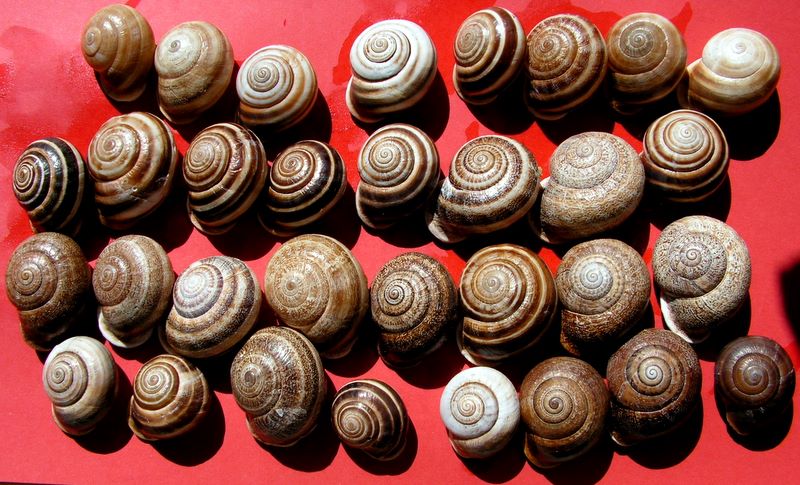Otala lactea
Milk Snail / Spanish Snail
Synonyms: Helix lactea, Iberus alonensis
Class: Gastropoda
Order: Stylommatophora
Family: Helicidae

Photographer: Guy-Gérard
Source: http://forums-naturalistes.forums-actifs.com/t5265-otala-helix-lactea-muller-1774
Description
The milk snail, Otala lactea, is a large, terrestrial and air-breathing snail that feeds on plants. As the picture shows you above, the shell of Otala lactea can be quite variable in coloration but is usually light brown with dark brown lines that spiral along the shells whorls. Archeology in Morocco has shown this snail was a staple of diets to prehistoric humans and in modern times it is considered a favorite from Spain to Italy.
Ecological Threat: Otala lactea is a fruit and plant feeding snail, which in small populations is more of a nuisance. In California, which has a Mediterranean climate similar to its native range, it is a more serious pest. In Mediterranean-like climates the snails can overrun native snails, displacing them and endangering the native population’s survival. Even though Otala lactea’s populations are smaller than native snails in more humid conditions.
Biology: Milk snails are herbivores that are only active at night, in their native habitats, and spend the hot time of the day in aestivation. During this time they close their shell aperture with a membrane from dried mucus, the so-called diaphragm and they also reduce their breathing rate to a fraction of the active value. This species produced an average of 66 eggs per clutch, and two clutches per month, depositing them in loose soil. While they tolerate and thrive in Mediterranean-like climates they do require moist sand for the deposition of eggs.
History: It has been widely introduced in the southeastern states, Arizona, and a number of California counties. The most documented entry point for this snail is the Tampa area since 1931, when the owner of a curio shop imported them from Morocco. However, it is believed that this snail was imported to Florida closer to the early 1900s.
U.S. Habitat: In nature, the milk snail lives in rocky, bushy heath lands and steppes; but in the United States it can be found in more humid areas in smaller populations.
Distribution
Native Origin: Eastern Mediterranean and North Africa
U.S. Present: CA, FL, GA, KY, LA, MD, MO, MS, NY, OH, PA, TX and VA
Management
Since the milk snail is an edible species, local chefs could start harvesting these invasive snails and feature them on the menu; this way the restaurant is offering a delicacy while encouraging the survival of native snail species.
USDA and APHIS do not have Otala lactea as an illegal import but do have guidelines for those trying to import this snail in to the United States: “While snails may not require a containment facility, their great reproductive potential and ability to escape coupled with their plant feeding activities means that great care should go into developing plans to house and contain them”. It is when proper housing or carelessness prevail, that these snails are able to establish themselves in environments they would not get themselves into. As with these invasive snails, it is highly encouraged to not import them, and if you do please follow the guidelines posted in the link below.
Guidelines posted by USDA and APHIS click here.
References
Dundee, D. S. 1974. Catalog of introduced molluscs of eastern North America (North of Mexico). Sterkiana 55:1-37.
Gamon,ET. 1943. Helicid snails in California. State of California Department of Agriculture Bulletin 32: 173-187
Pilsbry, H. A., 1939. Land Mollusca of North America (north of Mexico) vol. 1 part 1. Academy of Natural Sciences, Philadelphia. xvii + pp 1- 573 + ix.
Internet References
http://eol.org/pages/449912/overview
http://www.manandmollusc.net/molluscan_food_files/molluscan_food_terrestrial_one.html
http://www.jaxshells.org/1212p.htm
Back to Invasive Mollusks and Crustaceans
 Texas Invasive Species Institute
Texas Invasive Species Institute